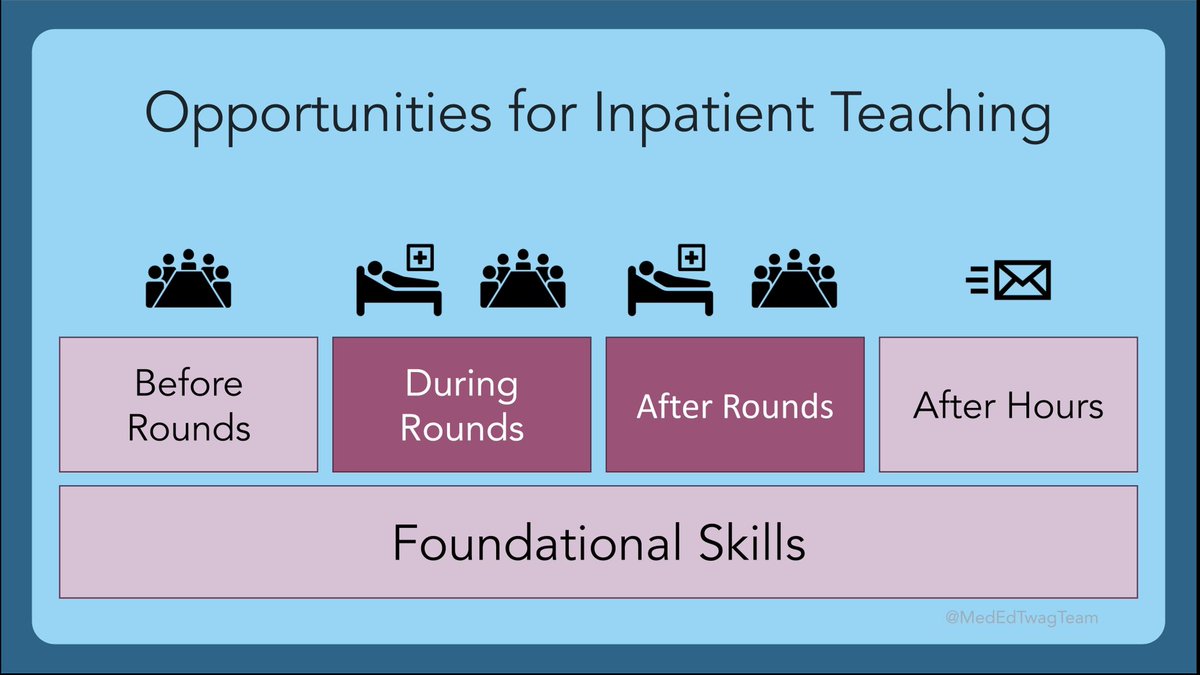1/ Your student is trying to characterize the pt’s aortic stenosis murmur. The pt looks concerned. The rest of your team looks bored, waiting to examine the pt.
How to make PE teaching fruitful & engaging for EVERYONE?
#TweetorialTuesday #MedTwitter #MedEdTwagTeam #MedEd
How to make PE teaching fruitful & engaging for EVERYONE?
#TweetorialTuesday #MedTwitter #MedEdTwagTeam #MedEd

2/ As a reminder, we are continuing our discussion about opportunities for inpatient teaching during rounds.
Today is the final installment on the physical exam.
Today is the final installment on the physical exam.

3/ You’ve decided to teach exam skills. You’ve prepped WHAT you’d like to teach.
But with so many different levels of learners on a team, keeping all your learners & the pt engaged can be a challenge during exam teaching.
But with so many different levels of learners on a team, keeping all your learners & the pt engaged can be a challenge during exam teaching.
4/ For a general framework on HOW to teach the exam, starting from team prep work to debriefing, check out my prior bedside teaching schema tweetorial!

https://twitter.com/YihanYangMD/status/1231902479761235970?s=20&t=LceCZ42Y6SzJbZ-d5hnT1Q

5/ Several of the strategies in the prior schema can be helpful to engage ALL your learners. We will cover the following 6 strategies 

6/ Expectations
✅Set & stick to time limits for exam teaching
✅Ask your learners what THEY want to learn from exam teaching
✅Tell learners (& patients) that you expect learners to say “I don’t know”
✅Set & stick to time limits for exam teaching
✅Ask your learners what THEY want to learn from exam teaching
✅Tell learners (& patients) that you expect learners to say “I don’t know”
7/ Assign Roles - Give everyone on your team a task or ? to ponder while they’re waiting to examine the pt.
This is a great way to assign learner level / learner goal specific teaching points!
This is a great way to assign learner level / learner goal specific teaching points!

8/ Question Up - Learners sometimes feel intimidated when asked ?s @ the bedside.
🗝Consider asking ? to your most inexperienced learner 1st, moving up if they don’t know the answer
🗝AVOID asking junior learner a ? that a senior learner got wrong
🗝Consider asking ? to your most inexperienced learner 1st, moving up if they don’t know the answer
🗝AVOID asking junior learner a ? that a senior learner got wrong
9/ Predictions - @GStetsonMD previously posted a/b prediction ?s for teaching:
This skill is helpful when teaching:
🔥variations on a finding
🔥how exam changes w/ clinical progress/deterioration
🔥correlation w/ imaging
This skill is helpful when teaching:
🔥variations on a finding
🔥how exam changes w/ clinical progress/deterioration
🔥correlation w/ imaging
https://twitter.com/gstetsonmd/status/1402291340092788736

10/ See 1 vs Do 1 - Decide if you want to demo the skill first, or if you’d like your learners to jump right in.
Consider demo if:
🗝 the skill is advanced/commonly done wrong
🗝 it’s early in team formation & you’re unsure of your learners’ skill levels
Consider demo if:
🗝 the skill is advanced/commonly done wrong
🗝 it’s early in team formation & you’re unsure of your learners’ skill levels
11/ Coach & Redirect - Praise what learners are doing well while also providing gentle corrections when needed 

12/ #MedTwitter, what other strategies do you use to engage learners when teaching at the bedside?
Did you pick up any new strategies for bedside exam teaching?
Did you pick up any new strategies for bedside exam teaching?
13/ But wait… what happened with the patient in all of this??
#MedTwitter previously identified several challenges with engaging pts while teaching at the bedside:
#MedTwitter previously identified several challenges with engaging pts while teaching at the bedside:

14/ Use the “PATIENTS” framework to engage patients while helping to protect their privacy and comfort.
For more details, check out my prior tweetorial:
For more details, check out my prior tweetorial:
https://twitter.com/YihanYangMD/status/1236964267179544576?s=20&t=LceCZ42Y6SzJbZ-d5hnT1Q

15/ For a quick summary & takeaway reference, please check out my bedside teaching cheat sheet: drive.google.com/file/d/1-7ieQl… 

16/ Stay tuned for next week’s intro thread on teaching communication at the bedside on rounds!
Make sure to follow @MedEdTwagTeam members @GStetsonMD @JenniferSpicer4 @ChrisDJacksonMD & @YihanYangMD so you don’t miss anything!
Make sure to follow @MedEdTwagTeam members @GStetsonMD @JenniferSpicer4 @ChrisDJacksonMD & @YihanYangMD so you don’t miss anything!

• • •
Missing some Tweet in this thread? You can try to
force a refresh






















